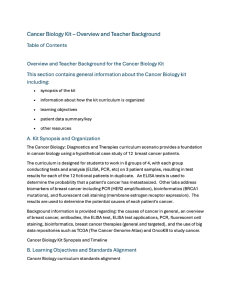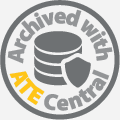Shoreline Biotech Experience Cancer Biology Kit

Curriculum Description:
The Cancer Biology Kit curriculum scenario, from Shoreline Community College, provides a foundation in cancer biology using a hypothetical case study of 12 breast cancer patients. The curriculum is designed for students to work in eight groups of four, with each group conducting tests and analysis (ELISA, PCR, etc.) on three patient samples, resulting in test results for each of the 12 fictional patients in duplicate. An ELISA (Enzyme-Linked Immunosorbent Assay) test is used to determine the probability that a patient's cancer has metastasized. PCR (polymerase chain reaction), bioinformatics and fluorescent cell staining results are used to determine potential causes of each patient's cancer.
Background information is provided regarding: the causes of cancer in general, an overview of breast cancer, antibodies, the ELISA test, ELISA test applications, PCR, fluorescent cell staining, bioinformatics, targeted breast cancer therapies, and the use of big data repositories such as TCGA (The Cancer Genome Atlas) and OncoKB to study cancer.
Curriculum Contents:
The Cancer Biology Kit is divided into the following nine folders:
- A - Overview and Teacher Background
- B - Reagents, Supplies, and Equipment
- C - Micropipetting and Serial Dilution
- D - Intro to Cancer
- E - ELISA - CA 27.29
- F - PCR and GEL Electrophoresis - HER2
- G - Fluorescence Staining - ER
- H - Bioinformatics - BRCA1
- I - Curriculum Development Acknowledgments
Folder A includes documents that provide an overview of the curriculum, including activities, learning objectives, resources, background readings, a cancer biology glossary, and standards alignment.
Folder B includes documents that provide information for teacher preparation; a prep packing list; reagent sourcing, storage, and preparation; and kit ELISA reagents and supplies.
Folder C includes coordinates for suncatcher pictures, teacher notes for making suncatchers, three micropipetting activities, and a serial dilution lab. In the micropipetting labs, students use pipettes, Falcon tubes, and colored water to make serial dilutions, focusing on accuracy and technique while producing a multicolored pattern in a 96-well plate. In the serial dilution lab, students learn the concept and technique of serial dilution by creating a series of twofold dilutions of a colored solution, demonstrating how each step reduces the concentration by half.
Folder D includes two activities, activity cards, worksheets and handouts, an icebreaker, and more. The activities are Classifying Cancer Genes and Examining Patient Data. In the first activity, students learn how changes in certain genes can cause cancer by identifying, classifying, and mapping cancer-related genes on human chromosomes. In the second activity, students analyze real cancer patient genetic data to find patterns in gene mutations, compare different cancer types, and discuss how these mutations contribute to cancer development.
Folder E includes documents related to ELISA, including a table of contents, teacher preparation guide, slide decks, an ELISA protocol, ELISA comparison graphic organizers and Venn diagrams. The teacher preparation guide explains how to prepare and run a simplified ELISA experiment to help students detect mock cancer biomarkers in patient samples, including rationale, solution preparation, labeling, and teacher tips.
The Measuring Protein Concentration: Enzyme-Linked Immunosorbent Assay ELISA slide deck includes "information about the immune system, antibodies, the ELISA test, biomarkers, the CA 27.29 protein, and uses of the ELISA test." The ELISA Model Sandwich Assay Cancer Biology Kit slide deck "contains the information necessary to assemble the ELISA models used in this curriculum." The ELISA protocol is an experiment that has students test patient samples to see which test positive for a biomarker linked to cancer metastasis.
Folder F includes materials related to PCR and gel electrophoresis, including a table of contents, activities, slide decks, and an assignment. The activities include Paperclip PCR, Analyzing PCR Results Using Agarose Gel Electrophoresis, and Identifying Gene Amplification Using Polymerase Chain Reaction (PCR). The slide decks include a single HER2 Gel Pic Key, and presentation slides titled the following: Agarose Gel Electrophoresis, Cancer Biology Kit PCR Data, and Identification of Gene Amplification Using Polymerase Chain Reaction (PCR). The worksheet assignment is titled PCR Animation and is a guided activity that goes with a linked interactive animation.
Folder G contains materials on fluorescent staining and its use in detecting cellular structures and proteins. The folder includes a table of contents, slide deck, activities, and related supporting documents. The Staining Protocol has students "... visualize cell structure and determine which patient cells over- express mER by staining Membrane-bound Estrogen Receptor (mER), Actin (cytoskeleton), DNA (nucleus)." The Modeling Cell Staining: Using Fluorescent Stain to Detect Over-expressed mER has students use fluorescent staining to visualize membrane-bound Estrogen Receptor (mER), actin, and DNA. Then students compare cells with low and high levels of mER expression to observe differences in staining patterns.
Folder H contains materials about bioinformatics and the BLAST program that can be used to analyze DNA and protein sequence information. Materials include a table of contents, a slide deck, activities, and a dataset. Activities include Instructions for Seeing Molecules in 3D, Tumor Suppressor and Oncogene Research, Comparing Influenza Protein Sequences Using BLAST, and Explore TCGA. The presentation slide deck is titled Using BLAST to Compare DNA & Protein Sequences: Cancer Biology & BRCA1 Genetic Testing and introduces the use of BLAST.
Folder I contains a document of acknowledgments and a bibliography of related resources. The acknowledgments list Shoreline College staff developers and other collaborators on this curriculum.
Below is a list of the files contained within the .zip attachment. The size of each file is included in parenthesis.
SBE Cancer Biology Kit Curriculum (96 files, 42.7 MB)
- Cancer Biology Kit - A - Overview and Teacher Background (13 files, 1.9 MB)
- Cancer Biology Kit - B - Reagents, Supplies, and Equipment (6 files, 889 KB)
- Cancer Biology Kit - C - Micropipetting and Serial Dilution (8 files, 2 MB)
- Cancer Biology Kit - D - Intro to Cancer (25 files, 19.1 MB)
- Cancer Biology Kit - E - ELISA - CA 27.29 (13 files, 6.1 MB)
- Cancer Biology Kit - F - PCR and Gel Electrophoresis - HER2 (11 files, 3.7 MB)
- Cancer Biology Kit - G - Fluorescence Staining - ER (8 files, 53 MB)
- Cancer Biology Kit - H - Bioinformatics - BRCA1 (8 files, 3.7 MB)
- Cancer Biology Kit - I - Curriculum Development Acknowledgments (2 files, 53 KB)
About this Resource

Comments